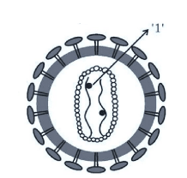EASY
Earn 100
Which of the following is called 'slipper animalcule'?
(a)Volvox
(b)Chlamydomonas
(c) Paramecium
(d)Euglena
50% studentsanswered this correctly
Important Questions on General Introduction and Classification of Microorganisms
MEDIUM
Select the wrong statements:
HARD
Observe this figure and answer the questions given below:

- Name the part labelled as ‘1’.
- Name the heredity material of this virus.
- The person infected by this virus is attacked by various diseases.’ Explain.
EASY
The daughter paramecia formed immediately after binary fission are
EASY
Ciliates differ from all other protozoan's in
EASY
A student was given three unlabelled permanent slides. In an effort to identify these specimens, she places the slides under the microscope and marks the following features:
slide Unicellular, two well-defined nuclei, ciliated, without a cell wall
slide Unicellular, chloroplast, one nucleus, biflagellated, with a cell wall
slide Unicellular, one nucleus, non-flagellate, with a cell wall
The organisms likely to be present on the slides and respectively, are
EASY
Entamoeba histolytica has
MEDIUM
Match the following
|
List - I Organism |
List - II Number of Flagella |
||
| (a) | Trypanosoma | (i) | Many |
| (b) | Euglena | (ii) | |
| (c) | Giardia | (iii) | |
| (d) | Trichonympha | (iv) |
The correct answer is
EASY
Name any two fungi.
EASY
Who discovered vaccine for small pox?
EASY
Name the micro-organism used in bread-making which makes the bread-dough rise. How does it make the dough rise?
MEDIUM
How do viruses differ from other micro-organisms such as bacteria?
EASY
Name any two viruses.
EASY
Which of the following is not true about viruses?
EASY
Name any two bacteria.
EASY
Name two diseases caused by Virus.
MEDIUM
Name the different types of microbes.
MEDIUM
Name two diseases caused by Fungi.
EASY
Amoeba and paramecium are examples of?
EASY
Chlamydomonas is an example of?
EASY
Understand the relationship and complete the following.
Example: Children: milk teeth:: Adult: Permanent teeth.
Bacteria: typhoid :: _____protozoa/virus: dysentery.

